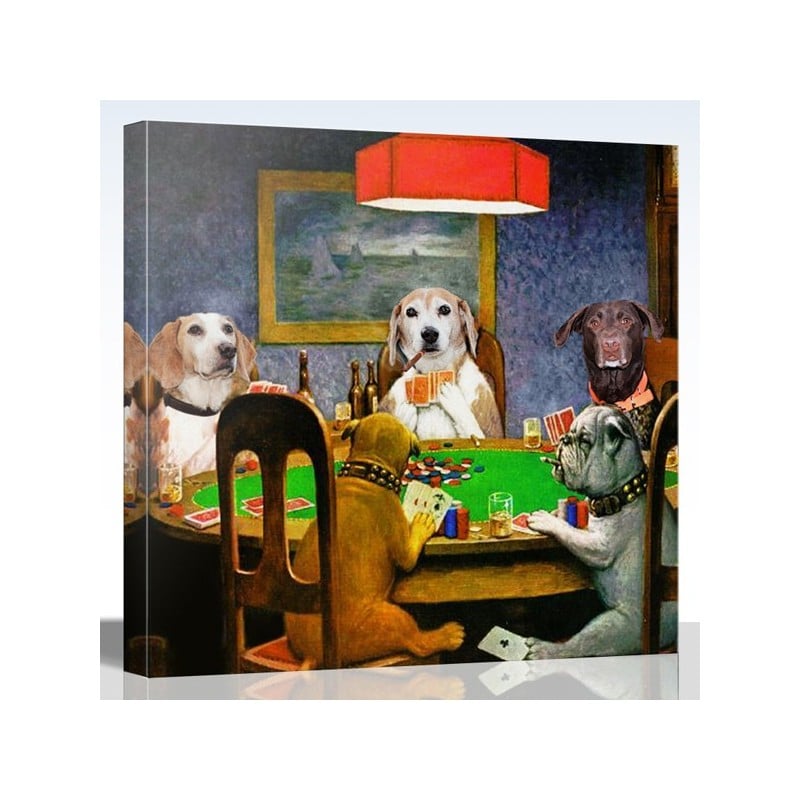Original Poker Dogs Painting
The legendary painting series Dogs Playing Poker was the vision of Cassius Marcellus Coolidge, known to some as the “Michelangelo of the dog world”. Although some might say that Coolidge’s style isn’t “serious” enough, his masterpieces are now some of the most iconic examples of quintessential American artwork. There’s actually more than one painting of Dogs Playing Poker. Dogs Playing Poker isn’t a one-hit-wonder it’s not the name of the painting at all. There is actually a serious of paintings of dogs and cards. Coolidge started his dog-depicting kick by painting dogs for cigar boxes in the late 1800s.
Born in 1844, Cassius Marcellus Coolidge had no formal art education, but in spite of this, he was selling his drawings to various magazines by 1864, when he was just 20 years old. Many of his artworks are signed “Kash”, which was one of his childhood nicknames, because his full signature was unintelligible. As an adult, Coolidge worked in many different jobs, including working as a banker, pharmacist and newspaper publisher. Coolidge even tried his hand at live presentations and appearances, which were very hit or miss. But his true passion lay with art, and he took many trips across America and Europe to draw the various sights and develop his skill.
He was in high demand as an illustrator, especially for children’s books with animals. Coolidge was known for his ability to take a sketch of an elephant walking up a hill and turn it into a masterpiece, with movement, strength and rhythm. He could create dramatic images of a tiger readying to spring by simply bristling the tigers fur in a certain manner.
At some point in his career, Coolidge took an interest in painting humanized dogs in typical human situations. He painted large and small dogs in courtrooms, at poker tables, and even did a painting of dogs on a football field. In 1893, a New York Sun article mentioned Coolidge’s picture with three large dogs playing poker. Just over ten years later, Coolidge was commissioned by Brown & Bigelow for their new cigar campaign.
Within a few years, the poker dogs pictures had gained a great deal of popularity, and were being offered as a set of prints named “Life in Dogville,” which came free with every purchase of 50 10-cent cigars from Cohen & Baker Cigar Co. Shortly after their debut on the cigar market, one of Coolidge’s original dog paintings sold for $3,000, which is roughly $75,000 nowadays.
The Dogs Playing Poker series refers to the collective group of Coolidge’s dog paintings, including his original 1894 painting, the 16 oil paintings that were commissioned in 1903 by Brown & Bigelow, and an additional 1910 painting he did. All eighteen of these paintings feature humanized dogs; however, only eleven of the paintings include dogs playing poker around a card table. These eleven pictures are the most well-known pictures, and are strongly associated with the home decoration of the working middle class population.
Brown & Bigelow still exist today and still sell Coolidge prints online. But after a chance encounter with Coolidge’s daughter, Marcella, a collector claimed a portion of Coolidge’s portfolio, which was dismissed by Marcella as her father’s junk. 40 years after Coolidge’s death, art historian Carla Davidson wrote an article about Coolidge in American Heritage, which sparked people to question the meaning behind each picture. Some believe the pictures are a commentary on the upper class; while other believe it is satire surrounding sexism and men in general.

In February 2005, the original paintings of Waterloo and A Bold Bluff sold as a pair at an auction for $590,400. In November 2015, Coolidge’s first painting, the 1894 Poker Game sold for $658,000 at a Sotheby’s sale in New York.
A Friend in Need 1903 C.M.Coolidge
_-_The_Cardsharps_-_Google_Art_Project.jpg)

When it comes to the world of art, poker isn’t just one of the many games available atbetsafe.com/en/casino – it’s also the theme of an iconic collection of paintings. Dogs Playing Poker by the American artist Cassius Marcellus Coolidge started life in 1894, when Coolidge painted the first image in the series, Poker Game. The oil painting depicts four bespectacled St Bernard dogs, sitting around a poker table, with cards and cigars clamped in their paws.
It might not be a ‘serious’ work of art, but it’s certainly fetched a serious price. In 2015, Poker Game was sold through the art dealer Sotheby’s for a staggering$658,000! (For context, that’s more than six times the price at which an original sketch by the famous portraitist John Singer Sargent was recently sold).
Over the years, Dogs Playing Poker has infiltrated our popular culture, with references to the work popping up everywhere from a Snoop Dogg music video to the beloved Disney Pixar film Up. So, what’s the story behind these iconic paintings? This article will guide you through Coolidge’s collection and explain why these poker-playing dogs continue to entertain us.

How many paintings are in the collection?

Dogs Playing Poker is the collective title for a series of 18 paintings. The first, Poker Game, was self-standing for almost ten years, until the Minnesota-based publishing company Brown & Bigelow commissioned Coolidge to create 16 oil paintings to advertise cigars in 1903. Of these 16, nine feature dogs playing poker – in the remaining seven, they enjoy other (distinctly dog-unfriendly) activities such as ballroom dancing, appearing in court, and reading the mail.
The collection was completed in 1910, when Coolidge painted Looks Like Four Of A Kind and brought the total number of artworks to 18.
How were the paintings received?
The fact that 16 of the paintings were originally created as advertisements means they occupy a strange position in the art world. Much as Andy Warhol would challenge us, over 50 years later, to consider the lines between art, advertising and pop culture, Coolidge’s Dogs Playing Poker intrigue us because they represent farcical ideas in the traditionally serious guise of an oil painting. In fact, many of the pictures are modelled on the compositions of works by the renowned artists Cézanne, Caravaggio, and Georges de la Tour.
Throughout the United States, the paintings have become classic examples of kitsch decoration – repeatedly reproduced, referenced, and modified, both as a bit of a joke and as pop culture’s homage to Coolidge. As the art criticAnnette Ferrara puts it, Coolidge is ‘the most famous American artist you’ve never heard of’ whose works have imprinted themselves on ‘even the most un-art historically inclined person’.
Although Poker Game is currently Coolidge’s most valuable painting, others in the collection have also sold for high prices. In 2005, the originals of Waterloo and A Bold Bluff were bought (as a pair) for $590,400 – outstripping the previous record price for a Coolidge, which was $74,000.
Original Poker Dogs Painting Images
Whether you love them or hate them, Dogs Playing Poker have become some of the most iconic paintings in America. Just be sure not to follow the example of Coolidge’s (obviously cheating) dogs when you play your own poker games.